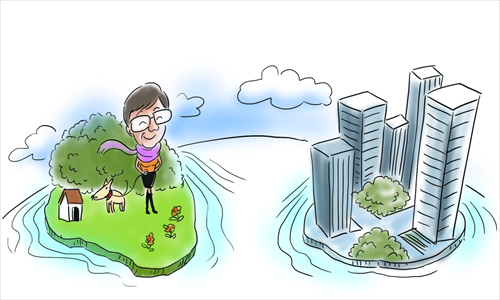HOME >> OP-ED
Population drives China’s hard urban limits
By Rong Xiaoqing Source:Global Times Published: 2015-9-24 18:23:01

Illustration: Liu Rui/GT
New York is a city that's never short of surprises, even when you have been living here for more than a decade. That became clear when I took some relatives from China on a tour around the city recently.Who would have expected the hawkers stationed around the Empire State Building to have grown so aggressive over recent years that we were harassed by several and chased after by one for two blocks? Many tourists now seem to bypass the observation deck in the building for the newly opened One World Trade Center, now the tallest building in the city.
Who would have thought that the horse carriages around Central Park would survive a mayor's campaign promise to ban them, and be still thriving almost two years later? Who would think that the High Line Park, built on an old elevated rail line, would now be like a valley surrounded by luxury apartments and hotels under construction on both sides? Who would know the 7 subway line has been extended to the far West side of Manhattan with an elegant new station?
My guests, an uncle and three aunts, had their own surprises, although theirs are very different from mine. They didn't know what life in the city was like a year, five years or 10 years ago. They can only compare it with what they are familiar with; life in China. The higher prices of food and lower prices of clothes, the visibly better air quality and the default friendliness of strangers are common topics.
But many of their comparisons focus on the orderly and people-centered way in which New York operates. There was a big difference from the bureaucratic and rigid ways they experience in China. For example, the lawns in the parks here are open for sunbathers and picnickers while in China they are often fenced off with chains and stepping across them will lead to fines. No one seems to be assigned to maintain order on the platforms in the subways here while in China security staffers often line up along the platforms to enforce all sorts of restrictions (such as "do not step over the yellow line.")
My uncle pointed out that bicycles can be put in the subway cars here while in China it is not allowed. An aunt, who has a puppy in China, was jealous of the ubiquitous doggie playgrounds in the parks and sighed that even kids don't have enough space to flex their muscles in China.
These views are in line with the impressions of the US written by first-time visitors from China in many blog entries. Mind you, many of them, parents of US-dwelling Chinese, landed in smaller cities or suburbs. I also made some similar observations when I visited my home country last year, the first time in six years. For example, I was perplexed by the dividers in the subway stations in Beijing that stretch for miles without a break. If you are on the wrong side, it will take you a long time to get back. For a moment, I blamed whoever designed the structure for being mindless.
But all these observations, correct as they are, overlook an important factor - the different populations in the US and in China, the former with 318 million and the latter 1.36 billion.
According to a study by Tsinghua University in 2005, Beijing's overall population density was 14,694 people per square kilometer, almost double that of New York. This figure has been going down in recent years thanks to the rapid urbanization of the rural areas around Beijing and the new administrative boundary of the city that now includes many rural areas. But the density in the central area of the city still remains more than 24,000 people per square kilometer, according to the statistics from the city government, similar to that of Manhattan.
China's giant population helps explain many major policies from the one-child policy to the temporary traffic controls that allow only some cars on the street on certain days based on their plate numbers. And it can also explain almost all the culture shocks mentioned above. In the more populous and crowded Chinese cities, an open lawn could quickly be damaged by many people stamping all over it, and uncontrolled passages in a subway station could easily be turned into a mad house.
But China's birth rate has dropped from 20 per 1,000 people in 1990 to today's 12. Its population of workers has been shrinking since 2012. A stagnant and aging population seems to be in the cards. But don't expect the obsession with order to fade anytime soon - it is part of the mind-set of many a bureaucrat, even if inconvenience comes with it.
The author is a New York-based journalist. rong_xiaoqing@hotmail.com
Posted in: Columnists, Viewpoint, Rong Xiaoqing